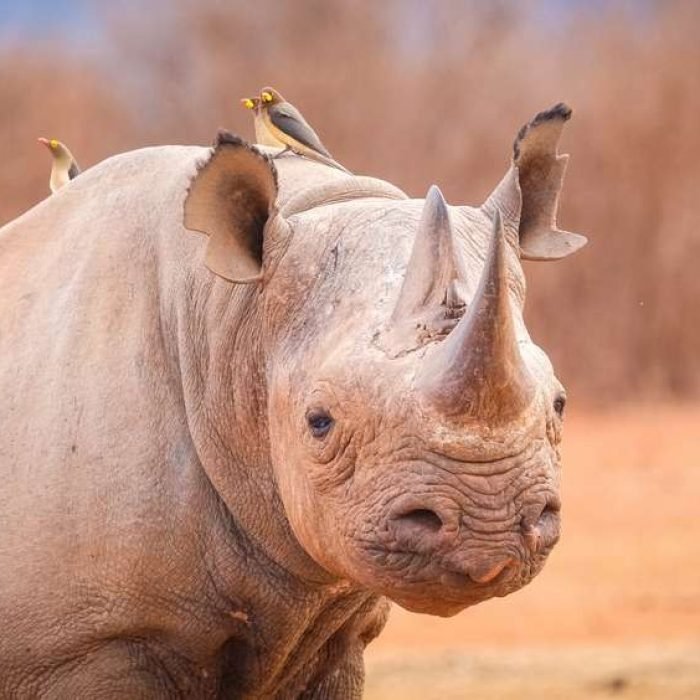Aardwolf
( maanhaar-jackal, termite-eating hyena or civet hyena )
- Proteles cristata
- IUCN Status: Least Concern
- Trend: increasing

General Information
The name Aardwolf means “Earth wolf” in afrikaans and dutch. They are insectivorous animals and are members of the hyena family. Unlike many of its relatives, the aardwolf does not hunt large animals. It eats insects and their larvae of mainly termites. An aardwolf can lap up as many as 250,000 termites during a single night using its long, sticky tongue. The aardwolf’s tongue has adapted to be tough enough to withstand the strong bite of termites.
Description
The aardwolf resembles a very thin striped hyena, but with a more slender muzzle, black vertical stripes on a coat of yellowish fur, and a long, distinct mane down the midline of the neck and back. It also has one or two diagonal stripes down the fore- and hind-quarters, along with several stripes on its legs. They have an incredibly slimey and sticky tongue.
Fun Facts
The Aardwolf is the cutest and smallest species of hyena. Unlike other types of hyena, they are solitary and insectivorous in that they eat mostly insects.
Ecology & Behaviour
Aardwolves are shy and nocturnal, sleeping in burrows by day. They will, on occasion during the winter, become diurnal feeders. This happens during the coldest periods as they then stay in at night to conserve heat. They have often been mistaken for solitary animals. In fact, they live as monogamous pairs with their young. If their territory is infringed upon, they will chase the intruder up to 400 m to the border of their territory. The territory is marked by both sexes, as they both have developed anal glands from which they extrude a black substance that is smeared on rocks or grass stalks in 5 mm streaks. Aardwolves are not fast runners nor are they particularly adept at fighting off predators. Therefore, when threatened, the aardwolf may attempt to mislead its foe by doubling back on its tracks. If confronted, it may raise its mane in an attempt to appear more menacing. It also emits a foul-smelling liquid from its anal glands.
Distribution & Habitat
Aardwolves live in open, dry plains and bushland, avoiding mountainous areas. Due to their specific food requirements, they are only found in regions where termites of the family Hodotermitidae occur. Termites of this family depend on dead and withered grass and are most populous in heavily grazed grasslands and savannahs, including farmland. For most of the year, aardwolves spend time in shared territories consisting of up to a dozen dens, which are occupied for six weeks at a time.
Diet
Aardwolves are shy and nocturnal, sleeping in burrows by day. They will, on occasion during the winter, become diurnal feeders. This happens during the coldest periods as they then stay in at night to conserve heat. They have often been mistaken for solitary animals. In fact, they live as monogamous pairs with their young. If their territory is infringed upon, they will chase the intruder up to 400 m to the border of their territory. The territory is marked by both sexes, as they both have developed anal glands from which they extrude a black substance that is smeared on rocks or grass stalks in 5 mm streaks. Aardwolves are not fast runners nor are they particularly adept at fighting off predators. Therefore, when threatened, the aardwolf may attempt to mislead its foe by doubling back on its tracks. If confronted, it may raise its mane in an attempt to appear more menacing. It also emits a foul-smelling liquid from its anal glands.
Reproduction
Aardwolves are shy and nocturnal, sleeping in burrows by day. They will, on occasion during the winter, become diurnal feeders. This happens during the coldest periods as they then stay in at night to conserve heat. They have often been mistaken for solitary animals. In fact, they live as monogamous pairs with their young. If their territory is infringed upon, they will chase the intruder up to 400 m to the border of their territory. The territory is marked by both sexes, as they both have developed anal glands from which they extrude a black substance that is smeared on rocks or grass stalks in 5 mm streaks. Aardwolves are not fast runners nor are they particularly adept at fighting off predators. Therefore, when threatened, the aardwolf may attempt to mislead its foe by doubling back on its tracks. If confronted, it may raise its mane in an attempt to appear more menacing. It also emits a foul-smelling liquid from its anal glands.
Conservation
The IUCN has rated the aardwolf as least concern due to them not decreasing in number and being widespread in east and southern africa.
Interaction with Humans
In some areas, they are persecuted because of the mistaken belief that they prey on livestock; however, they are actually beneficial to the farmers because they eat termites that are detrimental. In other areas, the farmers have recognized this, but they are still killed, on occasion, for their fur. Dogs and insecticides are also common killers of the aardwolf.















